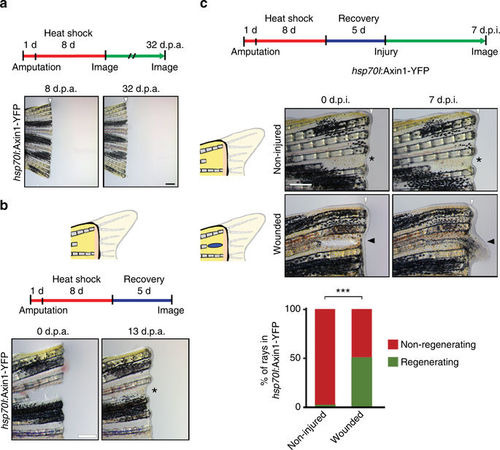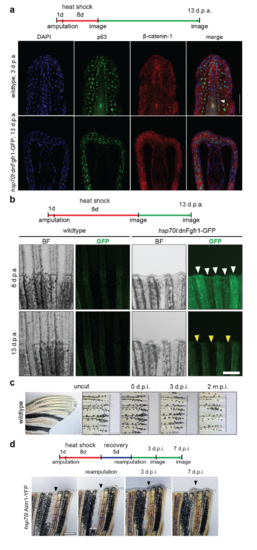- Title
-
Generic wound signals initiate regeneration in missing-tissue contexts
- Authors
- Owlarn, S., Klenner, F., Schmidt, D., Rabert, F., Tomasso, A., Reuter, H., Mulaw, M.A., Moritz, S., Gentile, L., Weidinger, G., Bartscherer, K.
- Source
- Full text @ Nat. Commun.
|
Epidermal wounds inflicted on dormant zebrafish fins induce regeneration. a Transient overexpression of a dominant-negative Fgf receptor-1 (dnFgfr1-GFP) until 8 days post-amputation (d.p.a.) blocked fin regeneration, which spontaneously resumed only in a minority of fin rays after relief from transgene expression. White arrowheads mark the amputation plane, n = 9 fish, 163 rays. b A stable missing-tissue context (dormant fin) can be produced by transient blockage of Fgf or Wnt/β−catenin signaling, which allows for wound epidermis formation but stably blocks fin ray regeneration. c Injury regimes applied to dormant fins. Re-amputation represents an R-wound, epidermal wounding an H-wound. Arrowhead points at epidermal wound. d Re-amputation (asterisk), as well as epidermal wounding (black arrowhead) re-initiated regenerative growth. Lower panels show magnification of boxed areas. The graph depicts the fraction of non-injured, re-amputated and epidermally wounded rays displaying regenerative growth at 3 and 7 days post-injury (d.p.i.). ***p < 0.001 χ 2 test. n (non-injured) = 449 rays, 61 fish, 3 experiments; n (re-amputated) = 30 rays, 28 fish, 1 experiment, n (epidermally wounded) = 84 rays, 61 fish, 3 experiments. Note that uninjured rays located next to regenerating rays frequently exhibited bystander growth (white arrowhead in box) in both wounding scenarios (see also Supplementary Fig. 9). Scale bars: 500 μm |
|
The wound epidermis of dormant fins is not a barrier to regeneration. a Transient inhibition of Wnt/β-catenin signaling using overexpression of Axin1 in hsp70l:Axin1-YFP transgenic fish resulted in a stable blockage of fin ray regeneration. n = 9 fish. b Amputation and heat-shock regime used to produce recessed rays in dormant fins. Note that interray skin healed distally to non-regenerating recessed rays (asterisk) despite Axin1-YFP expression. c Skin wounding applied to the skin distal to recessed dormant rays (black arrowheads) induced regenerative growth beyond the primary amputation plane. Asterisks indicate non-injured control rays. Graph depicts the fraction of regenerating rays. ***p < 0.001 χ 2 test. n (non-injured) = 48 rays, 48 fish, two experiments, n (wounded) = 69 rays, 50 fish, two experiments. Scale bars: 500 µm |
|
Generic wound signals initiate regeneration in missing-tissue contexts. a Injuries that normally do not trigger regeneration (H-wounds) do initiate regeneration in planarian dormant tails and zebrafish dormant fins (missing-tissue contexts). b Signals that are generically induced after all injuries have the capacity to initiate regeneration, but only when induced in missing-tissue contexts |
|
Regenerative responses but not formation of a wound epidermis are blocked in dormant fins a Longitudinal cryosections stained for the epidermal marker p63 and the cell surface marker β- catenin reveal that formation of a multi-layered wound epidermis did occur in hsp70l:dnFgfr1-GFP transgenic fish subjected to the indicated heat-shock regime. However, the basal layer of the epidermis, which is a hallmark of the specialized wound epidermis forming in regenerating fins, is only evident in wild-type fins at 3 d.p.a. (white arrowhead), but did not form in the FGF signaling inhibited fins. b Heat shocks applied 4x daily resulted in robust expression of dnFgfr1-GFP in hsp70l:dnFgfr1-GFP fish in ray and inter-ray tissue by 8 d.p.a. (white arrowheads). After a 5-day recovery period, GFP expression was no longer detected in inter-ray tissue (yellow arrowheads) and fluorescence in rays had dropped to background levels observed in wild-type fish. BF, bright-field image. c Surgical removal of the skin at the distal tip of non-amputated fins did not result in ray growth, even when followed to 2 months post injury (m.p.i.). Dashed line indicates the injury plane. n=17 fish, 67 rays. d Re-amputation of individual rays induced regenerative growth in recessed rays (8 of 8 rays) of dormant hsp70l:Axin1-YFP transgenic fins (black arrowheads), white arrowheads indicate the primary amputation plane. n = 8 fish. Scale bars: a, 100 μm; c,d, 500 μm |




